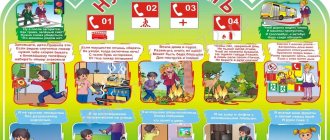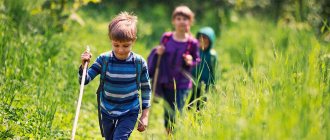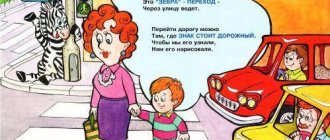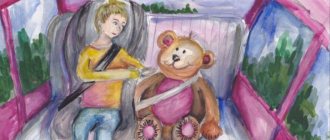Presentation “Safety in kindergarten” presentation for the lesson (senior group)
Slide 1
MDOU "Kindergarten No. 68" Safety of children in preschool educational institutions Completed by: teacher Aravina Galina Ivanovna
Slide 2
Please study this information! Make sure that your children and other members of your family are familiar with it. It is important for everyone to know: how to protect yourself, protect your health and life, save your family, children, loved ones and friends. Remember the telephone numbers of services that will always come to your aid. 101 - fire protection and rescue 102 - police 103 - ambulance 104 - gas emergency service 112 - rescue service (universal number).
Slide 3
Child safety factors in children's educational institutions are of interest to both teachers and parents. For the former, it is important to uncompromisingly ensure children's safety, while the latter want to be sure that their baby will be protected from all sides. In this article we will look at the problem from both sides. Because, despite the final goals of educators and parents, in the end everyone has their own tasks. So, let's start with general theses and dot the i's. The safety of children in kindergarten is ensured by the administration and employees of the children's educational institution, and the task of parents is to know and monitor the implementation of basic safety requirements in the educational institution to which they are going to send or have already sent their child. If any discrepancies are identified, parents must notify the responsible persons. Why did parents get control over only basic requirements? Because many factors lie beyond the capabilities and competence of parents. For example, control of infectious diseases among employees of preschool institutions. Now in more detail and about everything in order.
Slide 4
The safety of children in kindergartens and its main aspects The head of a children's educational institution has a number of mechanisms by which he can control and improve the safety of children located on the territory of a preschool educational institution (DOU). At the same time, the director is guided by national and regional laws regulating the requirements for child safety. To fulfill assigned tasks and comply with standards, the head issues orders, improves the educational process, hires the necessary personnel, gives appropriate instructions to kindergarten employees and attracts contractors. Parents also have the right to provide voluntary assistance to the preschool educational institution in cash or material resources, as well as to take part in the improvement of the kindergarten. No one has the right to force parents to take such actions in state preschool educational institutions.
Slide 5
Physical safety of children in kindergarten The physical safety of each child consists of creating conditions that guarantee the protection of the health and life of children throughout the entire educational process. In this case, a threat can be considered both external (terrorist, criminal, inappropriate behavior of adults) and internal (technical condition of buildings and territory, the presence of dangerous areas and objects). To ensure the safety of children, it is necessary to systematically monitor the condition of the preschool educational institution; each kindergarten employee must have instructions on how to interact with rescue services and public utilities. First of all: police (militia), ambulance, gas service, fire and rescue services. A mechanism for interaction with emergency services and an action plan in case of an emergency must not only be developed, but also tested in a training environment. To do this, it is usually necessary to conduct evacuation training sessions at least twice a year to develop clear skills in staff and children. It is always necessary to take into account regional characteristics and the dangers associated with this. In most countries of the former post-Soviet space, leasing preschool premises is prohibited by law, but even if this is not the case, to ensure safety it is necessary not to take tenants and not allow cars to drive on the territory of the kindergarten. The installation of a “panic button” to call law enforcement officers and firefighters, as well as an alarm system, is very helpful in ensuring the safety of children. A manual for ensuring safety on the territory of a children's educational institution should be developed for staff. Only immediate parents are allowed to give children away. Children can be given to other people only with the prior written consent of the parents.
Slide 6
Safety of children's health in a preschool institution For the safety of children's health and the prevention of infectious and colds, the preschool educational institution must maintain temperature conditions, ventilation and lighting conditions in the premises, and there should be no drafts. Personnel must regularly undergo medical examination to ensure the absence of infectious diseases. The staff of the preschool educational institution must have a nurse who monitors the condition of children and, if necessary, calls an ambulance. There should be regular monitoring of the sanitary conditions of the kindergarten, and especially the kitchen and the products in it. The supply of products must only be those that are approved for baby food and have the appropriate certificates. The head of the preschool educational institution and the staff physician must draw up and control the menu so that it is harmonious in terms of calories and safe for the child’s body. In the kindergarten, premises must be cleaned daily and disinfected periodically. Children and staff must observe good personal hygiene. Children must undergo regular examinations in medical institutions, and in the case of individual characteristics of the body and immunity to certain foods, this should be taken into account in the kindergarten menu.
Slide 7
Fire safety in children's kindergarten Premises of preschool educational institutions must comply with fire safety rules, and flammable structures must be treated with fire protection agents. Also, the premises must have an emergency exit, fire extinguishers, a fire corner with primary fire extinguishing equipment: sand, buckets, shovels, hooks. It is necessary to systematically check the performance of hydrants. Personnel must be trained in fire prevention and what to do in the event of one. There should also be floor plans with evacuation diagrams. Children should be given classes on fire safety rules and visual materials and posters should be used. It is periodically necessary to practice fire safety rules in practical training sessions with children. Preferably at least four times a year. The condition of electrical equipment and the electrical network, as well as kitchen stoves and ventilation systems must be monitored in the room. It is desirable to have a fire alarm in the preschool premises
Slide 8
Safety of children in kindergartens during emergencies Emergency situations (ES) include man-made or natural disasters, as well as riots, wars, and so on. In the event of an emergency, children's institutions should be alerted first. The kindergarten must ensure the safety of children in emergency situations before handing over the child to parents or the relevant guardianship authorities. The priority task of parents who are not involved in eliminating the consequences of an emergency is the safety of their own children. Preschool personnel must have clear instructions on how to act in the event of an emergency and be able to clearly interact with civil defense authorities, rescue services, and know gathering places for evacuation or shelter. Children must have a piece of paper with them containing information about their parents or guardians.
Slide 9
Preventing injuries and reducing the risk of accidents Unfortunately, even the most stringent safety measures do not exclude accidents. This is especially true in the case of young children, who are characterized by active behavior, which, coupled with unorganized coordination of movements and poor orientation in space, can lead to tragic consequences. To minimize injuries, strict control and organization of children’s actions in accordance with the daily routine is necessary. Children should move from one point to another in pairs, holding hands. The teacher should always make sure that all children reach the end point. The gaming and educational process must take place under the strict control of the teacher and not pose a threat to health and life. It is forbidden to leave children alone without the supervision of a teacher or his assistant. It is necessary to conduct classes with children about the rules of behavior at home, on the street, in nature and traffic rules. Premises and children's furniture and playgrounds must be injury-proof. Large furniture that could fall on a child should be secured to the wall. And the process of walks, games, learning, nutrition is clearly regulated and mandatory for all preschool staff. This is especially important in the case of active games and nutrition. Hot food should not be poured into plates when children are nearby. Items for play must be safe for children and appropriate for their age. Sharp corners on the street and indoors must be closed, low-lying glass must also be covered, and mirrors must be reinforced on the back with a special armor film, which will strengthen the mirror and prevent it from breaking into sharp fragments. In winter, ice and icicles from roofs must be removed from the area.
Slide 10
Safety of children in kindergartens - a view from the parents Every parent, sending their child to kindergarten, wishes him only the best conditions. But life makes its own adjustments, especially if children's educational institutions are overloaded and there is not much choice. But in any case, parents should not perceive kindergarten as a mercy from above. You should remember that the constitutions of almost all countries of the post-Soviet space (Russia, Ukraine, Belarus, etc.) guarantee children free preschool and school education. Therefore, “lack of places” is not a problem for parents at all. The district education department and each individual head of a preschool educational institution should worry about this. And the state education system is obliged to provide you with a place in kindergarten. To ensure maximum safety for your child, when sending your child to kindergarten, be sure to notify the group’s teachers about the individual characteristics of the body. If a child goes to a nursery group, it is not advisable to immediately enroll him for the whole day. Start with a few hours so that your baby gets used to it. For older children, always find out how they feel and what incidents happened in the group during the day. In general, always try to be in live contact with the teacher. At the same time, do not create conflicts over trifles, but also do not allow any major problems to arise. Also try to minimize requests of a secondary nature or tasks that are not at all part of the direct responsibilities of the teacher and do not directly affect the quality of the educational process or the safety of the child, for example, wishes to weave yellow bows for the girl and similar “whims”. You, as parents, must realize that a teacher in a group has dozens of children who require not only attention, care and control, but also training and development, so, of course, one teacher cannot fully work with each child as if he were alone. Regarding safety issues in the kindergarten. Conduct an independent inspection of the group and kindergarten. Check the quality of fastening of wall cabinets, the tightness of windows, the absence of sharp corners and objects dangerous for children. In the area where children walk, make sure there are no old trees, dangerous elements on the playground, holes, sharp pipes sticking out of the ground, etc. Inquire about fire safety measures and training activities for children and staff. If gross safety inconsistencies are found, notify the teacher or manager. Of course, you shouldn’t immediately go into direct conflict and “dictate” the rules. The dialogue should always be conducted in a friendly, recommendatory form. Preferably, even in the form of personal assistance. For example, in writing a collective letter from parents to the district education department to allocate funds for some safety measures. In difficult situations, you should contact higher authorities to restore order or change the kindergarten to a safer one
Presentation on the topic Child safety at home
Memo for parents “Child safety at home” Child safety is the main link in the complex of raising a child.
It is necessary to take precautions against injury to the child because children under 7 years of age show great interest in objects around them, in particular electrical appliances, audio and video equipment and explosive objects. Ensuring the safety of a child at home is a set of precautions that includes the safety of all components of your home (kitchen, bathroom, bedroom, living room, etc.)! A preschool child must be under the supervision of adults (parents, teacher, nanny). Do not leave your child at home alone for a long time! \ But if you still had to leave, then first: Have a preventive conversation with him, explain which of the objects around him can cause injury to him, the use of which devices is strictly prohibited for him. Keep your child busy with safe games. Close windows and exits to balconies; if necessary, you can leave vents or transoms open. Close the gas valve on the pipe. Remove pots and kettles with hot water from the stove - knocking them over can cause burns to a child. Check that toys are placed correctly; they should not be at a height exceeding the child’s height, as a child, trying to get a toy from the cabinet, may be injured if it falls. If the baby is afraid, and even more so cries, under no circumstances should you forcibly leave him at home alone. Otherwise, it will take a very long time to rid him of his fears, and for a very long time he will not be able to remain alone, even in the next room! Turn off and, if possible, isolate from the child all electrical appliances that pose a danger to him. Keep matches, sharp, breakable and flammable objects away from your child. Keep medications and medications (tablets, solutions, ointments), dishwashing and cleaning products away from your child. They can cause irritation to the mucous membranes of the eyes, burns to the surface of the skin, and poisoning. Make sure that your child is supervised, well-groomed, clothed, fed and explores the world with you through the objects around him weburok.com






